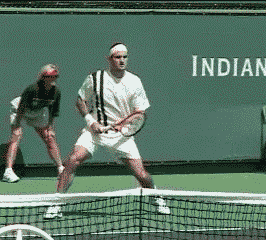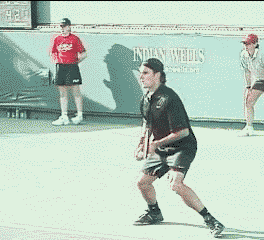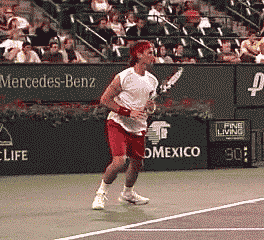|
TennisOne Lessons The Eyes of a Champion Alan Chandronnait So, what is the secret to hitting the ball with control and consistency? Ask Roger Federer, he's definitely got it dialed in. You can see it every time he plays. It's in his eyes. He is one of the few professionals to truly understand how to use his eyes effectively on the court. This may be the main reason why so many of the other pros are looking to catch up to him. Okay, obviously a great serve, huge forehand, incredible movement and amazing shot creativity are major reasons for his success also!
When asked about his ability to keep his eyes on the contact point his reply was, “I guess it was a mixture of coaching, luck, and talent.” Well, most of us will never learn to serve like Federer or hit that monster forehand but, surprisingly enough, you can develop his same eye control! What is his secret? Look at the videos of Roger hitting his ground strokes and watch how Roger is able to control his eyes to stay on the contact point. The contact point is where the strings and ball make contact. Can the human eye actually see the contact point? No. It occurs in .005 of a second! Too fast for the human eye to see. But, Roger tracks the ball to the contact point and keeps his eyes on what looks like a “yellow flash” until he completes his follow through. This is how he hits the ball solidly and consistently again and again. You can do it also!
The Yellow Flash To understand how to keep your eyes on the “yellow flash” and still allow your head to rotate slightly on the follow through, hold your finger about a foot in front of your face and watch your fingernail as you turn your head slightly from side to side. Many times on the complete follow through, with the eyes staying on the “yellow flash” only one eye can really see the spot where the yellow flash was because your nose gets in the way. If you do this correctly you will hit solid shots more consistently solid. When you get really good at it, the feeling is that you own the contact point. Some players even notice that the ball seems to be traveling slower or even getting bigger. Rod Laver once commented that when he played well, the tennis ball looked to him to be the size of a basketball. Looking Up Early
Carlos Moya's eyes come off the contact point during the stroke. If you look at the video of Carlos Moya you can clearly see his eyes coming off the contact point or yellow flash. Many of the other pros do the same thing. They have hit so many practice shots that they have a good idea where the ball is going to be but they are really guessing. Roger isn't guessing! He is using his eyes to make sure his contact is solid. Below are some drills to help you see the yellow flash just like Roger. You want to control your eyes by keeping them on the yellow flash until you complete your follow through. At first the drills are going to feel like you are keeping your eyes on the yellow flash too long…..and you probably are! The purpose is for you to start to get a feel of what it is like to control your eyes. In real match play a player should look up from the yellow flash once they have completed their follow through. Just like Roger. Drop Hit Drill Stand just behind the baseline and drop hit a forehand. When you swing keep your eyes on the flash until you complete your follow through. Keep your eyes on the spot where your strings and racket make contact until you hear the ball hit the court on the other side. Keeping your eyes on the flash this long is not what you want to do in a match but it is an excellent drill to develop eye control. Even though you are tempted to look up to see where the ball has gone keep your eyes on the yellow flash until you hear the ball hit the court on the other side.
Feed Hit Drill Stand just outside the baseline and have your coach or friend feed you a ball. Hit the shot making sure your eyes stay on the contact until you complete your follow through. You can also have your coach or friend say “OK” to tell you when you can look up. Do this with both the forehand and backhand ground strokes. Rally with your coach or friend and after each shot say, “Yes”, if you kept your eyes on the yellow flash until you have completed your follow through or, “No”, if you failed to keep your eyes on the flash and looked up to see the ball before you completed your follow through. Usually if you see it go into the net you have looked up early. Be Like Roger You may not be able to hit a backhand like Roger Federer nor can you expect to have his grace and incredible foot speed but you can have the same eye control! With practice you can see the flash as well as Roger and, by controlling your eyes; you will own your contact point. By owning your contact point during a match it will act as a mantra or a focal point. By focusing on seeing the flash on each point, it will help you stay in the present. By staying in the present you will again be like Roger! Because champions play in the present! Your comments are welcome. Let us know what you think about Alan Chandronnait's article by emailing us here at TennisOne . |



